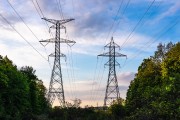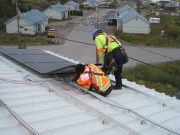This is the fourth publication in Climate and energy policy advancements: Eliminating diesel in Canada’s remote communities, a series providing insights, details, and analysis of each of the specific policies we are advocating for under our Renewables in Remote Communities (RiRC) program and the Indigenous Off-diesel Initiative (IODI).
 Indigenous communities that are transitioning from diesel energy to renewables face significant barriers in financing the required infrastructure. The high capital costs associated with the development of clean energy projects, specifically in remote communities, prevent these projects from moving ahead at a pace necessary to eliminate diesel in a timely fashion.
Indigenous communities that are transitioning from diesel energy to renewables face significant barriers in financing the required infrastructure. The high capital costs associated with the development of clean energy projects, specifically in remote communities, prevent these projects from moving ahead at a pace necessary to eliminate diesel in a timely fashion.
But governments can create the policies and programs that will give Indigenous communities better access to the money they need, either by providing financing themselves or by fostering the conditions that promote private investment.
Reliable clean energy in remote communities reduces environmental emissions that negatively impact health and overall quality of life, while allowing residents to take part in a sector that has been an economic success in other parts of the country. For those reasons, we urge governments to adopt policies to further the flow of capital to the Indigenous communities that are ready to move past diesel.
Removing financial barriers
Governments that wish to remove the financial barriers faced by Indigenous communities as they build clean energy can do so in a number of ways. They can, for instance, provide money directly to pay for clean energy infrastructure that will be constructed and owned by a remote Indigenous community. Some examples of government funding programs for Indigenous energy projects are:
- Clean Energy for Rural and Remote Communities (CERRC) Program. Managed by Natural Resources Canada, CERRC is a six-year $220 million funding program to support clean energy projects in Canadian remote communities. Started in 2018/19, the program was designed to displace diesel fuel for both power and heat in remote communities through renewable energy, smart-grid technologies, energy efficiency, and energy storage projects. The program also encourages the installation of biomass heating and combined heat and power systems for community and industrial applications.
- Northern Responsible Energy Approach for Community Heat and Electricity (REACHE) Program. Managed by Crown-Indigenous Relations and Northern Affairs Canada (CIRNAC), this program funds Northern remote communities in Canada’s five Inuit regions (Yukon, Northwest Territories, Nunavut, Nunavik, and Nunatsiavut) to develop renewable energy and energy efficiency projects to offset diesel usage for heat and power. The program has a committed $53.5 million budget, over 10 years, which started in 2018/19.
- BC Indigenous Clean Energy Initiative (BCICEI). This funding program is administered by the New Relationship Trust and is funded through the federal government’s Strategic Partnerships Initiative and B.C.’s CleanBC plan. The goal of BCICEI is to accelerate the implementation of clean energy projects by providing up to $500,000 worth of funding to each project being developed by an Indigenous community. The fund can be used toward feasibility and site selection activities; environmental review and permitting; project design and engineering; and demand-side management.
These types of direct government investments reduce financial risks, from the perspective of banks and other lenders, and make it easier for remote Indigenous communities to raise additional debt capital that may be needed to cover the total costs of the project.
Indigenous debt capital funding
Debt capital, as the name suggests, refers to financial resources that are committed to an energy project with the obligation that they will be repaid, at an agreed interest rate. Examples of Indigenous debt capital funding programs include:
- Alberta Indigenous Opportunities Corporation (AIOC). The AIOC provides loan guarantees to Indigenous communities that want to develop natural resource projects such as energy, mining and forestry. They also offer Indigenous capacity support (legal, technical, and economic expertise) to establish long-term strategic partnerships with industry and the Alberta government.
- Indigenous Community Infrastructure Initiative (ICII) Program. Recently launched by Canada Infrastructure Bank (CIB), the ICII program provides low-cost and long-term loans to support Indigenous, community-based projects across the CIB’s five priority sectors: clean power, green infrastructure, public transit, broadband, and trade and transportation. This debt capital is an additional tool for Indigenous communities to combine money from other federal funding programs and/or with private and institutional investments to accelerate the development of clean energy infrastructure projects.
The role of private equity
In tandem with, or separate to, the various government funding programs, Indigenous communities may also use their own equity or attract private equity by partnering with private clean energy developers or corporations. This private equity is becoming easier to access with the widespread adoption of Environment Social and Governance (ESG) standards by Canadian businesses. ESG-based projects encourage companies to demonstrate their commitment to ESG principles in measuring the profitability of their investments.
Attracting private equity encourages synergies between the private sector and Indigenous communities, which enables the communities to shift from diesel to more sustainable and cleaner sources of energy. Partnerships between the private sector and Indigenous communities also create low-risk profiles for energy infrastructure projects, making them a preferred investments from the point of view of lenders, particularly those that have secured Power Purchase Agreements (PPA) with a public- or private-power utility. Together, this improves the business economics of Indigenous renewable energy projects.
Beyond closing the energy infrastructure gap
The renewable energy funding landscape is changing. Indigenous communities have expressed their ambitions to have major equity ownership in developing renewable energy projects. Their ambitions should be signals for governments to promote economic reconciliation while prioritizing the aspirations of Indigenous leadership. Providing more direct funding and debt capital through innovative policies, strategies, and flexible programs will help shift the landscape and bring much needed private investment into this space. After all, even considering the great progress in diesel reduction over the past several years, there is still a very long way to go. Governments do not have enough money to fund this transition alone and must implement more aggressive policies to bring more private sector or investment capital to these communities.
Policies that provide incentives to the private sector
The pool of available capital in the market is limited. To ensure that it is directed at clean energy infrastructure in remote communities, governments should explore innovative policies that provide incentives to the private sector to partner with Indigenous communities. Examples of these incentives include:
- The federal government can incentivize projects that are practicing early and respectful engagement with Indigenous communities. This ensures that the communities are given ample time to prepare, and to provide input that will improve the business case of the projects. It will also help to ensure that the relationships are built on true partnerships. Indigenous people must be engaged as capable business partners and not just participants in the projects.
- Governments should also adopt policies that push private partners in clean energy projects to ensure that as a minimum 50 per cent of the ownership of those projects is in the hands of the community developing the project. Allowing Indigenous people and businesses to own a majority stake in energy projects fosters empowerment and self-determination, which helps to connect social and economic goals for everyone involved.
The federal government may consider these incentives as “adders” that help to improve the business cases of clean-energy projects with PPAs that have been co-developed by Indigenous communities and private partners, or look to renewable energy tax incentives to further encourage private sector investment. The criteria that incentivize private sector investments can complement production incentive programs that were introduced by the previous federal government (including the Wind Power Production Incentive and ecoENERGY for Renewable Power). Policy signals such as these can be better than inflexible checklists and requirements in promoting the construction of renewable energy projects and creating conditions that allow Indigenous people to take control of the economic development in their own communities.
Strategic partnerships and innovative funding policies are key to further accelerating Indigenous energy projects. And Indigenous communities must also be the ones calling the shots on the construction of the renewable energy generation infrastructure that will distribute power and heat to their residents, and allow them to transform their energy landscape to match their own visions.

Climate and energy policy advancements: Eliminating diesel in Canada’s remote communities
Publications in this series:
- Rethinking energy policy in Canada’s remote communities
- How to boost renewable energy integration in remote communities
- What’s a fair and equitable price for renewable energy in remote communities?
- Better government policies will unlock the cash remote Indigenous communities need for clean energy
- Reducing emissions from diesel generators in remote communities
- When business-as-usual is a barrier to clean energy
- From diesel dependency to energy empowerment
- Three clean energy options that could help replace diesel
- Remote communities transitioning to clean energy need better housing
- How remote communities should be included in the push to electrify transportation
- Government action on UNDRIP and the clean energy transition







